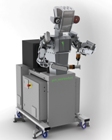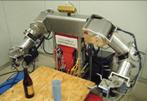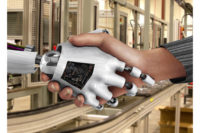
TUM-Rosie This robot has occasionally been
making breakfast sausage for researchers at the TUM Intelligent Autonomous
Systems Group for nearly two years. Photo courtesy www.geekosystem.com
TUM-Rosie
Hard at work in the Technical University Munich (TUM) kitchen is the dual-arm robot known as TUM-Rosie. This robot has occasionally been making breakfast sausage for researchers at the TUM Intelligent Autonomous Systems Group for nearly two years. TUM-Rosie collects sausages, puts them in a pot of boiling water, waits for them to be cooked, then places the cooked sausages in a serving bowl.The robot features two KUKA lightweight LWR-4 arms mounted on a rectangular platform that sits on an omnidirectional base. Four-fingered DLR-HIT hands are mounted to the arms.
Rosie was taught 3D models to identify the pot, localize and scoop out the sausages at the right time, and identify the bowls.
Torque sensors in the arm joints provide depth perception so the robot can connect exactly with the desired objects. Visual and perceptual algorithms enable Rosie to calibrate the cooking utensil and use it as a tool.
TUM researchers hope Rosie will help them develop a dual-arm robot with a high degree of cognition, one that can intelligently perceive environments, reason about them, autonomously infer the best plausible actions and successfully execute them.

Researchers who developed the Pi4-Workerbot hope
manufacturers will lease the robot as needed to meet changing workforce
requirements. Photo courtesy Fraunhofer Institute for Production Systems and
Design Technology IPK
Pi4-Workerbot
Researchers at the Fraunhofer Institute for Production Systems and Design Technology IPK in Berlin have developed the Pi4-Workerbot, hoping it will be flexible enough to use for industrial inspection and assembly. The researchers hope manufacturers will lease the pi4 as needed to meet changing workforce requirements.Similar in size to a human being, the robot features two arms, three cameras, fingertip sensitivity and can even produce a variety of facial expressions. The robot’s size allows it to be employed at almost any modern standing or sitting workstation.
Each of the workerbot’s arms has seven degrees of freedom with an additional rotation joint that corresponds to the human wrist. This flexibility allows the robot to transfer a workpiece from one hand to the other, as well as view a complex component from all angles.
The robot’s three cameras include a forehead-mounted 3D camera to capture its general surroundings and two other cameras that perform inspection. This setup allows Pi4 to inspect one aspect of an object with its left eye and another aspect with its right eye at the same time.
As for fingertip sensitivity, if the robot’s grip strength is set correctly it can hold an egg without cracking it, says Dr. Ing. Dragoljub Surdilovic, head of the working group at the Fraunhofer Institute.
Finally, Pi4 can make different facial expressions. When work is going smoothly it smiles. When the robot is waiting for work, it looks bored-indicating to the production manager that the production process can be sped up.

This dual-arm robot can digitize 3D coordinate
data from a stereo camera and detect positional measurements. The stereo camera
serves as the head of the robot. Photo courtesy graduate school of engineering at
Chiba University
Chiba University in Japan
In 2007 Kenzo Nonami and Shingo Amano of the graduate school of engineering at Chiba University in Japan developed a dual-arm robot that can digitize 3D coordinate data from a stereo camera and detect positional measurements. The stereo camera serves as the head of the robot, with the camera’s dual lenses being the robot’s eyes.Each robot arm has 7 degrees of joint movement, similar to a human arm, and both arms are powered by a DC servo motor. The arms can move in conjunction to grasp and weigh unknown objects and make multidynamic 3D nonlinear movements.
At the end of each arm are three-finger grippers powered by an AC servo motor. The robot also has optical sensors and measures 0.8 meter wide, 0.8 meter long and 1.1 meters high.
“In the future, we hope to develop an industrial robot capable of automatically assembly product components such as nuts and bolts in a factory,” says Shingo Amano. Other future applications envisioned for the robot include rescue emergencies, and nursing assistance and outer space development.


